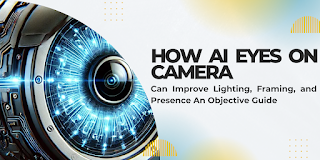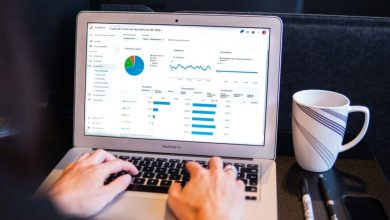How AI Eyes on Camera Can Improve Lighting, Framing, and Presence During Screen Recording

Introduction
In today’s digital world, being on camera is now part of regular professional life. Whether you’re pitching to clients, teaching a class, leading a webinar, or recording YouTube content, how you look and sound on video affects how others see you. A shaky camera, poor lighting, or little eye contact can quickly lower trust and interest.
This is where AI eyes on camera technology helps during screen recording. These smart features improve lighting, auto-adjust framing, and make eye contact look natural. Instead of making you manage ring lights, webcams, and editing tools, AI does the hard work in real time. They cut setup time and cut editing work, so you can present with more confidence. They also help teams keep steady video quality across people and sessions. Used with tools like AI notes, which capture and sum up conversations, the pair lets professionals focus on what matters: clear communication and real connection.
This guide shows how AI presence tools work, why they matter, and how to use them the right way.
Why On-Camera Presence Matters in the Digital Era
Video calls and online content have grown fast. In the US alone, millions of workers use Zoom, Microsoft Teams, or Google Meet every week. First impressions on these platforms matter as much as in face-to-face meetings.
Poor lighting can make you look unprofessional or even untrustworthy. Bad framing, like being half out of view, can distract viewers. Most important, low eye contact makes talk feel distant and cold. People read eye contact as a sign of trust and confidence, which is why AI eyes on camera features have such a big effect.
Understanding What AI eyes on camera Really Means
When we talk about “AI eyes on camera”, we mean computer vision tools that watch your position, gaze, and room in real time. These systems can:
- Make your gaze look like you are staring at the camera, even if you glance at notes or another screen.
- Reframe the video so your face stays centered as you move.
- Virtually relight your image without lamps or studio gear.
This is not the same as simple “beauty filters” or fixed virtual backgrounds. Rather than adding layers, AI eyes on camera changes how your presence is captured and shown. It runs with little setup and works in real time to help you appear natural.
Lighting: How AI Improves Visibility and Mood
Good lighting makes a big difference on video. Daylight can change, and indoor lights can make odd shadows. A late-night call without a lamp can make you seem tired, and bright windows can wash you out. **AI eyes on camera** helps by relighting your face and background on the fly. With live changes to brightness, contrast, and color balance, it gives a clean, professional look without extra kit, and it works continuously during calls. For example:
- Low-light: AI brightens your face while leaving the background dim.
- Overexposed: It reduces glare from strong windows.
- Mixed lighting: AI evens out uneven light so you look well lit.
For MacBook Air or PC users on the move, this is very useful. Instead of bringing a ring light, you can use AI eyes on camera to be camera-ready instantly. This saves time and helps teams keep a steady, high-quality image across meetings. Use it wisely.
Framing: Keeping You Center Stage
Have you ever leaned to one side of the frame during a meeting, or shifted a little while presenting? Poor framing pulls attention away from your message. AI auto-framing keeps you in the middle of the shot, copying a camera operator’s steady move. With AI eyes on camera, the system follows your motion, changes the crop, and keeps your head and shoulders in the right place. This not only looks more polished but also quietly shows authority and focus. In classrooms, sales calls, or live streams, a cen…
Presence: Building Authenticity and Confidence
Being present is more than just being seen; it is about making a connection. Here’s how AI eyes on camera raises that presence:
- Simulated eye contact: Even when you look at slides or notes, AI fixes your gaze so it seems you are looking straight at your audience. This builds more engagement and trust.
- Facial clarity: Small fixes improve contrast and sharpness so expressions are easier to read.
- Guided feedback: Some tools give live tips to cut fidgeting or correct posture, helping speakers look more sure.
When used with AI notes, presence becomes stronger. Picture giving a talk where AI keeps your eyes facing the audience while also making a clear transcript and list of action items. You look sure, and you do not need to worry about missing points.
Practical Applications Across Industries
Business & Sales
For people pitching clients, a neat look matters. A clear frame, well-lit face, and steady eye contact raise confidence and make pitches more convincing.
Education
Teachers in online classes gain from light and gaze fixes. Students stay focused when it feels like the teacher speaks to them directly.
Content Creation
YouTubers, creators, and podcasters save time on setup. AI eyes on camera makes solo recording simpler, while AI notes help plan future content.
Healthcare & Telemedicine
Doctors can build trust by keeping eye contact and clear view during patient calls, even when the setting is not ideal. Use these tools thoughtfully: check privacy settings, follow consent rules, and explain to viewers how any video data is used and stored.
Challenges and Ethical Considerations
Despite the benefits, there are key concerns:
Privacy: AI tools need access to facial data and video feeds. Users should check platforms have clear data policies and retention rules in place.
Authenticity: Over-enhancing presence can make communication feel “fake.” For example, if simulated eye contact does not match natural speech, it can feel odd. Such mismatches can distract viewers and lower trust.
Disclosure: In professional or educational settings, users may need to disclose when enhancements are used to avoid misleading people. Be open with your audience and explain what changed.
The key is balance: using AI eyes on camera to improve communication, not distort it.
Future of On-Camera AI Enhancements
- The next generation of AI eyes on camera will likely:
- Track multiple participants and adjust focus in group settings.
- Work smoothly with AR and VR platforms for immersive presence.
- Pair with AI notes so professionals can speak naturally while the system handles gaze correction, lighting, and meeting summaries at once.
This points to a future where technology cuts distractions and boosts human connection.
Conclusion
On-camera presence is not optional anymore. Whether in a boardroom meeting or a livestream, how you look affects how others see your skill and trust. AI eyes on camera tools bring clear benefits by improving lighting, framing, and simulating eye contact in real time. When used with AI notes, they let professionals focus on people and ideas instead of technical hurdles. The message is clear: authenticity does not have to mean unpolished. With the right AI presence tools, you can present yourself naturally while technology removes distractions. Next time you join a call or record content, try enabling a tool with AI eyes on camera.

Source: How AI Eyes on Camera Can Improve Lighting, Framing, and Presence During Screen Recording




